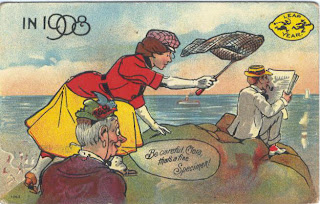A leap year (or intercalary or bissextile year) is a year containing one additional day (or, in the case of lunisolar calendars, a month) in order to keep the calender year synchronized with the astronomical or seasonal year. Because seasons and astronomical events do not repeat in a whole number of days, a calendar that had the same number of days in each year would, over time, drift with respect to the event it was supposed to track. By occasionally inserting (or intercalating) an additional day or month into the year, the drift can be corrected. A year that is not a leap year is called a common year.
February 29 is a date that usually occurs every four years, and is called leap year day. This day is added to the calendar in leap years as a corrective measure, because the earth does not orbit around the sun in precisely 365 days.
Folk traditions
In the British Isles, it is a tradition that women may propose marriage only on leap years. While it has been claimed that the tradition was initiated by Saint Patrick or Brigid of Kildare in 5th century Ireland, this is dubious, as the tradition has not been attested before the 19th century. Supposedly, a 1288 law by Queen Margaret of Scotland (then age five and living in Norway), required that fines be levied if a marriage proposal was refused by the man; compensation ranged from a kiss to £1 to a silk gown, in order to soften the blow. In some places the tradition was tightened to restricting female proposals to the modern leap year day, February 29, or to the medieval (bissextile) leap year day, February 24.According to Felten: "A play from the turn of the 17th century, 'The Maydes Metamorphosis,' has it that 'this is leape year/women wear breeches.' A few hundred years later, breeches wouldn't do at all: Women looking to take advantage of their opportunity to pitch woo were expected to wear a scarlet petticoat—fair warning, if you will."
In Denmark, the tradition is that women may propose on the bissextile leap year day, February 24, and that refusal must be compensated with 12 pairs of gloves.
In Finland, the tradition is that if a man refuses a woman's proposal on leap year day, he should buy her the fabrics for a skirt.
In Greece, marriage in a leap year is considered unlucky. One in five engaged couples in Greece will plan to avoid getting married in a leap year.

A person born on February 29 may be called a "leapling" or a "leaper". In common years they usually celebrate their birthdays on February 28 or March 1. In some situations, March 1 is used as the birthday in a non-leap year since it is the day following February 28.
Technically, a leapling will have fewer birthday anniversaries than their age in years. This phenomenon is exploited when a person claims to be only a quarter of their actual age, by counting their leap-year birthday anniversaries only. In Gilbert and Sullivan's 1879 comic opera The Pirates of Penzance, Frederic the pirate apprentice discovers that he is bound to serve the pirates until his 21st birthday rather than until his 21st year.
For legal purposes, legal birthdays depend on how local laws count time intervals.


Post a Comment